Alfonso Cuaron, Jane Campion and More Directors Praise 2023 Films


This year started with bright promise — the COVID pandemic seemed to have been tamed, festivals thrived and summer blockbusters ruled once again, with the combo of “Barbie” and “Oppenheimer” pushing 2023 into iconic status. But despite the WGA and SAG-AFTRA strikes, great films found their audiences, and a handful of helmers got personal with praise of their favorites.
More from Variety
‘All of Us Strangers’
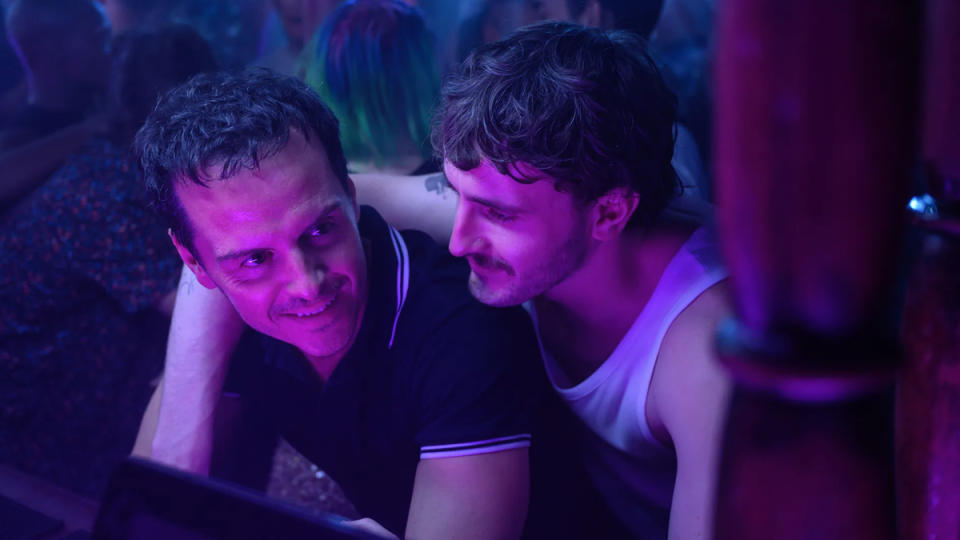
Directed by Andrew Haigh
Essay by Edgar Wright
Andrew Haigh’s “All of Us Strangers” is so delicately crafted and intimately performed that it almost seems wrong to discuss its immaculate construction. Andrew, as a director, has a remarkable ability to create films that are both elegant and stylish, but never lose sight of the deep emotions of the story or the humanity of the characters. I’ve always been very impressed with his work, not least the powerful “45 Years,” and though his latest film left me, like the rest of the packed cinema I saw it with, devastated, to only talk of the profound sadness within, would be to deny how funny and beautiful it is too. Andrew has, once again, delivered a film that is so impressively intricate in its narrative construction and overlapping themes, that unpicking the intricacy of his tapestry seems wrong. Sometimes it’s OK just to marvel.
What captivates me about this film, mirroring the book it is based on, is its use of classic ghost story elements to commune with the dead in ways both sublime and heartbreaking. The waking dreamlike structure where Andrew Scott’s Adam is able to meet his long-deceased parents at his current age provides an opportunity for discussion and closure that many desire, but can never have. But while Adam can talk to them now, the conversations are still haunted by what is not said.
One particularly deft sequence, exemplifying Andrew’s skills in constructing a scene and his beautiful directing of the actors, unfolds not with dialogue, but with song. As an adult, Adam and the ghosts of his parents decorate the family Christmas tree while layers of nuance permeate the scene. Physically regressing to his childhood, Adam experiences this annual tradition again while the song playing on the TV, the Pet Shop Boys cover of “Always on My Mind,” holds different meanings to his Elvis-loving parents than it does for their son grappling with his sexuality. That scene, devoid of any words other than the parents singing the song back to their now-adult child, is masterful.
This moment is just one of many that utilize genre and structure to uncover new understanding. Andrew is able to make a film that is somehow dreamlike and wrenching. On a note of pure envy, his musical choices throughout are perfect; a descent into madness set to Blur’s “Death of a Party” is so brilliantly done that I was able to temper my jealousy.
I have long felt that specificity is universal and Andrew is able to imbue the film with detail, such as the use of his childhood home of Croydon, in a way that, though it may not be directly personal to me, still resonated powerfully. I am of the same age as Andrew and while we have different lives, the memories of growing up in the ’80s under the shadow of AIDS left me aching. I will also say that having lived through the pandemic in an almost deserted new apartment building in London was something I directly and painfully related to; the term “phantom flats” has never been so apt.
I am in awe of what Andrew managed to do in this film. It’s a true testament to his artistry that he was able to make a film so personal, emotional and resonant, yet also so satisfying within its place in a genre. Though a traditional ghost story might end on a note of sadness or shock, the fact that Andrew is able to leave us with a moment of infinite beauty is to be cherished.
Edgar Wright’s films include “Last Night in Soho,” “The Sparks Brothers,” “Baby Driver” and the Three Flavors Cornetto Trilogy: “Shaun of the Dead,” “Hot Fuzz” and “The World’s End.”
‘American Fiction’
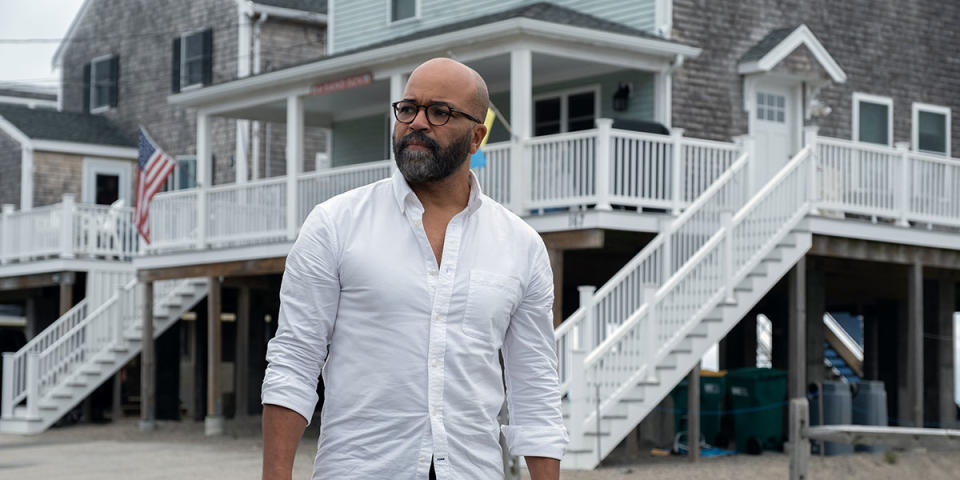
Directed by Cord Jefferson
Essay by Gina Prince-Bythewood
Your first film should tell the world who you are as an artist. With “American Fiction,” Cord Jefferson has screamed into a bullhorn. Bold, chaotic, unflinching, personal. Cord has channeled his creative truths into a searing indictment of biased norms. As artists of color, we recognize all of it. The best humor comes from truth, and he yields laughter as a weapon. Forces offenders to pay attention. To take a look at themselves. But Cord wants more. He wants the world to see our humanity. So he couples his blistering satire with a heartbreaking family drama. With characters who are flawed works of progress searching for peace within themselves, and with each other. The chasm within the family feels real and recognizable, and we root for reconciliation because we want it for ourselves. The poignant moments hit harder because of the audacious humor. It’s a tightrope, and Cord manages to balance both without a stumble. His collaboration with Jeffrey Wright is a triumph, giving the actor the words and space to create a performance that conquers that same tightrope. Cord is a writer/director and he wholly owns this vision. This is a first film that excites us all for what’s to come next.
Gina Prince-Bythewood broke out with “Love & Basketball,” and has directed films such as “The Secret Life of Bees,” “The Old Guard” and “The Woman King.”
‘Fair Play’
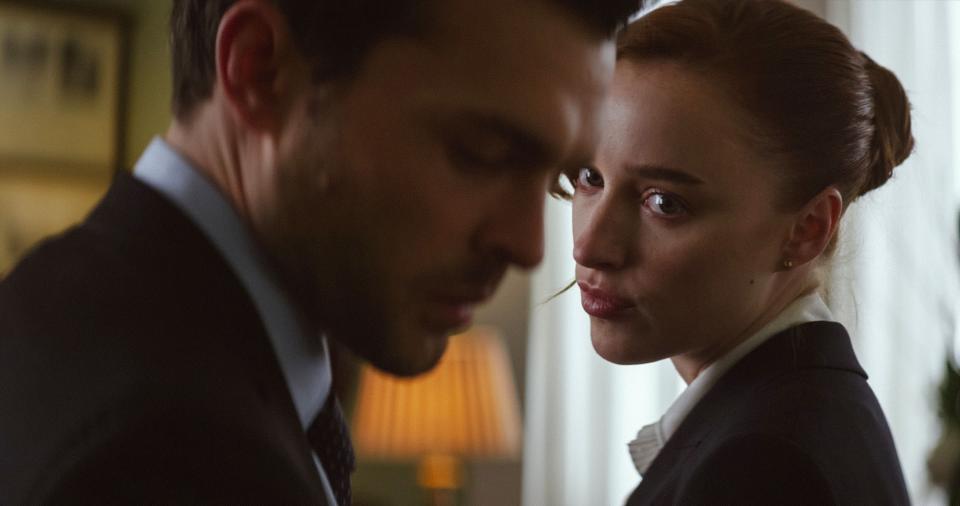
Directed by Chloe Domont
Essay by Olivia Wilde
Chloe Domont has joined the ranks of Fincher and Kubrick by brilliantly using our most basic human greed to craft a cinematic grownup nightmare. The monster hiding under this proverbial bed is a fragile male ego, twisting and gnashing at the threat of being undermined by the success of his bride-to-be. “Fair Play” is a riveting, sexy, thriller that begins and ends with blood on the floor, and this filmmaker sure as hell isn’t cleaning it up for you.
Domont begins by letting us fall for a fairy tale about modern love, through the eyes of Phoebe Dynevor’s preternaturally brilliant Emily, but nothing at Harvard or Goldman Sachs could prepare her for the test of achieving success while in a relationship with an insecure man. When it is his promotion we are celebrating, the score is soulful and romantic, the framing intimate and safe, but when it is hers, there is no Champagne in the shower, only her guilty apology and his bitter acceptance. Alden Ehrenreich’s gorgeously entitled Luke contorts from prince to villain with hideous self-righteousness, balking at Emily’s achievements with patronizing incredulity. Only the camera seems to know how dangerous Luke is, creeping towards Emily’s exposed jugular as she clings desperately to the possibility of repairing a relationship that will undoubtedly destroy her. Patriarchal conditioning has taught her that abandonment is a fate worse than self-annihilation, and only once her delusions of justice are shattered can she understand how powerful she really is.
Good chemistry is usually defined by a convincing display of crackling romantic tension, but Domont shows us something much more difficult: the chemistry of rage. A sex scene is one thing, but a viscerally believable argument is much more challenging, especially when the writing is this unflinching. Once the dam breaks, and the fairy tale is officially dead, Emily and Luke are unselfconsciously vicious, frothing and clawing with brutal honesty.
“Fair Play” seems to dance confidently on the third rail of our nerves. Most directors spend entire careers attempting such a successful emotional experiment. Luckily for us, Domont is just getting started.
Olivia Wilde’s films include “Don’t Worry Darling” and “Booksmart.”
‘Fallen Leaves’
Directed by Aki Kaurismäki
Essay by Dean Fleischer Camp
Ever since I discovered “The Match Factory Girl” in college, Aki Kaurismäki has been one of those filmmakers for whom I drop everything and run to see their latest work. I typically leave the theater with a dopey grin on my face and a renewed enthusiasm for humanity — strange, considering he makes movies exclusively about miserable people in very cold places.
“Fallen Leaves” is no exception. It’s a rom-com, or the closest a Kaurismäki joint will ever get to one, about a pair of endearing misfits who eke out solemn existences on the margins, one as a lonely grocery store clerk and the other as a devoted alcoholic. In the face of much misfortune, they somehow find the connection they’ve been missing. For how long have they been missing it? Who knows. What year is it? Not important. Where are they even? Dunno, by appearances — some kind of retro-dystopian Helsinki that is lit like a Douglas Sirk movie and looks like a bruised banana. All of this somehow makes it feel timeless and wonderful.
As always, Kaurismäki weaves the story with a delicate touch, infusing the film with genuine warmth even while maintaining his trademark deadpan. It’s a niche he carved out for himself long ago, and which has held widespread influence over a range of future auteurs including Yorgos Lanthimos, Roy Andersson and Jim Jarmusch (to name just a few). But of the bunch, Aki feels to me like the only one whose deadpan is balanced with such piercing compassion.
As a filmmaker, this balance is what I admire most. Kaurismäki tells sincere stories about marginalized peoples struggling for the basic stuff — food, shelter, dignity, love. But the films themselves are bone-dry comedies which encourage us to laugh at the protagonists’ misfortunes, or at least at the absurdity of the world’s indifference to them. And by depicting such sympathetic underdogs with such a coolly detached brush, Kaurismäki evokes in us, the audience, our very best. When the lights come up, I feel radicalized toward empathy and sincerity, ready to take up arms against the cynicism within myself and against the ironic posturing that is pop culture’s favorite self-defensive crouch.
In the press, Aki has maintained a kind of hilariously committed-to-the-bit “cool guy” schtick for going on 40 years now. But he may also be cinema’s greatest living humanist. With “Fallen Leaves,” that humanity is on full display, reminding us that love conquers all.
Dean Fleischer Camp directed “Marcel the Shell With Shoes On” and is helming “Lilo & Stitch.”
‘Fingernails’
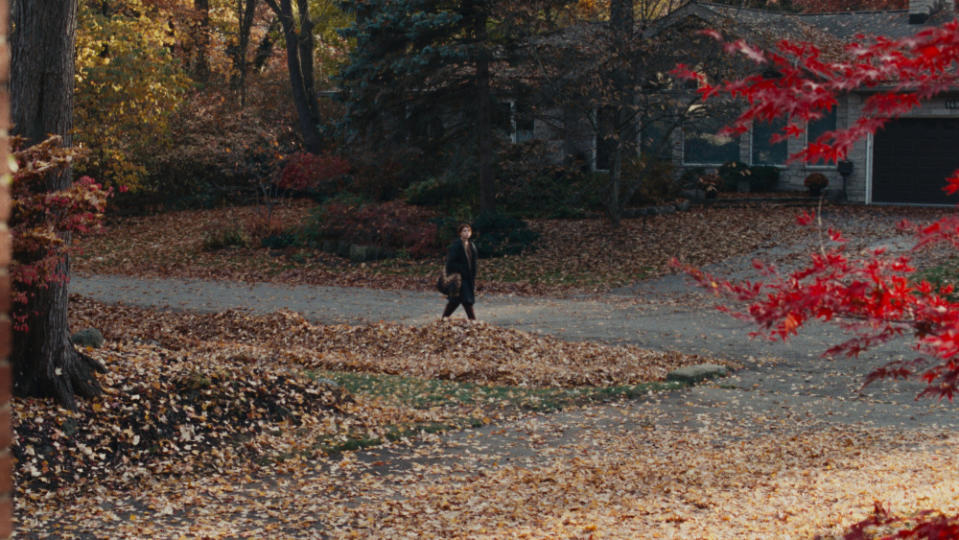
Directed by Christos Nikou
Essay by Gary Ross
I remember reading George Saunders monumental “Tenth of December” and being both awe-struck and perplexed. Was it speculative fiction set partially in the future, or was it a searing examination of the present, unearthing layers of existence that we refuse to look at?
Christos Nikou’s “Fingernails” is similarly set a half-step into the future, wrestling with themes of intimacy and emotional disconnection. Over two hours, it paints the portrait of an analytic and technologically advanced culture that has the capacity to quantify everything, but feel nearly nothing. (The act of digital self-mutilation that gives the film its title is an attempt to feel something, anything. … Perhaps only physical pain is an objective truth in this world.)
Is “Fingernails” futuristic? That’s the most intriguing thing about the film as it walks the line between now and when — prodding us to wrestle with the question of how plausible this might be in the real world. As the film progresses — and as nuanced performances emerge from Jessie Buckley, Riz Ahmed and Jeremy Allen White — we realize this is no simple morality play, but something deeply felt. Under the weight of its allegory, a lovely and intimate film emerges about feeling, trusting one’s personal truth and finding the courage to love. What better thing is there to make a movie about?
Gary Ross has directed such features as “Pleasantville,” “The Hunger Games” and “Seabiscuit.”
‘The Holdovers’
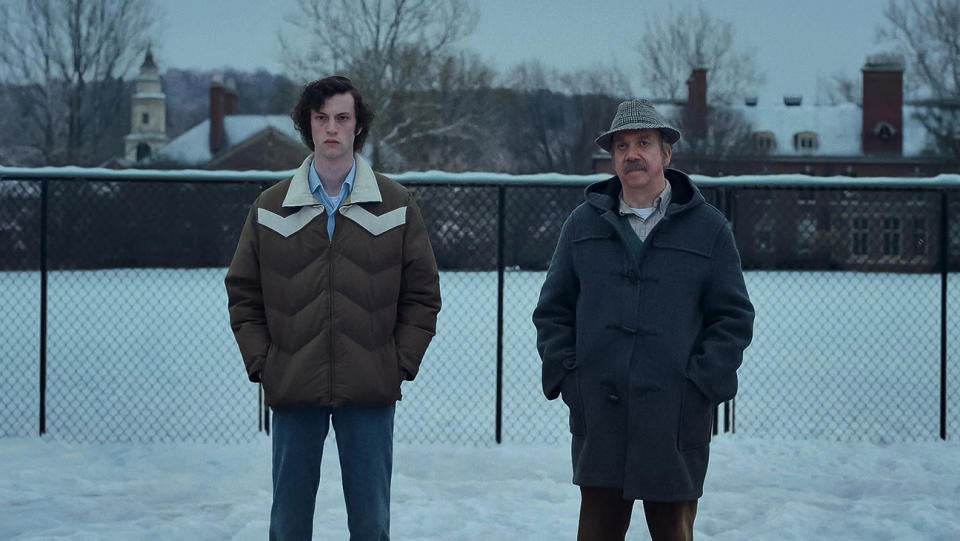
Directed by Alexander Payne
Essay by James Gray
Alexander Payne makes big films. Sometimes, it may not seem that way: they are often enclosed, microcosmic works, preoccupied with behavior that isn’t always pleasant to behold and detail that isn’t always edifying. But the work is relentlessly honest, and the pictures strive boldly to explore the vast landscape of the soul. Thank heavens for that. His is the kind of cinema rooted in the tradition of the New Hollywood, a truly golden era that featured human stories, told on a human (and humane) scale.
His new work, “The Holdovers,” is no exception — yet here, Payne (along with his wonderful screenwriter David Hemingson) sharpens further his focus on character and moral inquiry. “The Holdovers” is the story, principally, of three human beings — perfectly imperfect, idiosyncratic yet noble, struggling yet unbowed — who find themselves trapped by the confines of class and race. They don’t, cannot, hope to transcend; but the movie empathizes most deeply with their quiet rage and heartbreak. The performers are Paul Giamatti, Da’Vine Joy Randolph and Dominic Sessa. To watch them, you wouldn’t know they were acting at all.
The film takes place in 1970, the first year of American history’s greatest hangover. And the rhythms and look, precisely rendered, lend a bracing authenticity to the proceedings. More important, the movie recalls vividly both that era’s glorious dreams and the stinging cost of idealism. These lonely souls may seem doomed, but they’re still trying. And though bearing witness may not always be pretty, it is beautiful. So is “The Holdovers.”
James Gray’s films include “Armageddon Time,” “Ad Astra” and “We Own the Night.”
‘The Iron Claw’
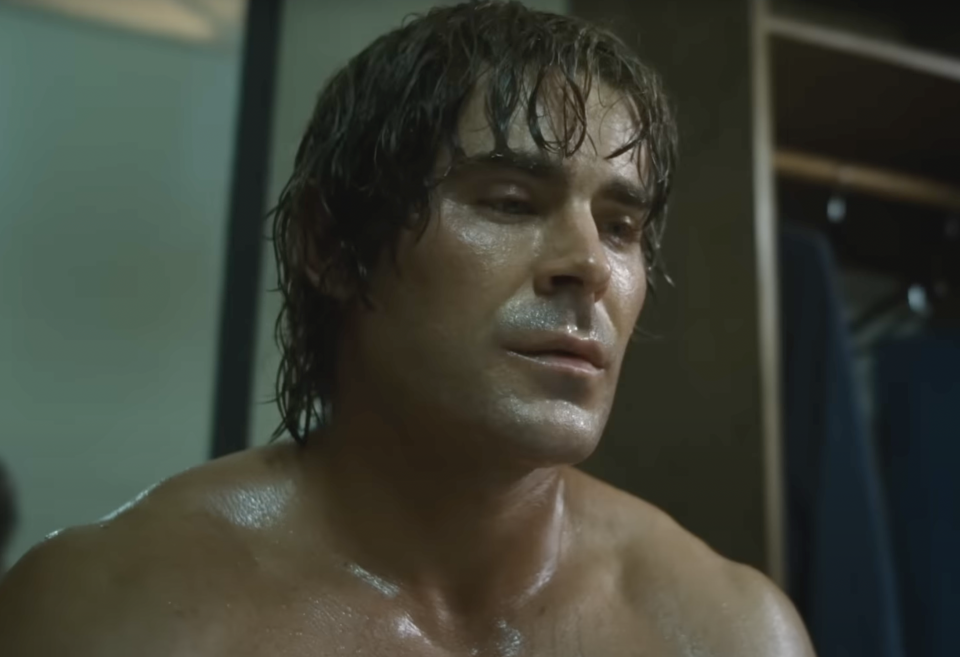
Directed by Sean Durkin
Essay by David Lowery
Consider the way Sean Durkin moves the camera in “The Iron Claw” — or rather, look at how often he doesn’t! Characters drift through his compositions, occasionally provoking a pan or tilt but more often leaving the frame undisturbed, rock-solid, as self-assured as his protagonists aspire to be. When Zac Efron, as Kevin Von Erich, is first seen in the film, his movie star closeup gives way to fleeting impressions of masculinity: muscles, veins, whitey-tighties, a quilt made for a little boy. In another shot, the lens holds its focus on the rope of the wrestling ring as Efron hurls himself towards it, only in focus for a few frames at a time, literally incapable of finding the resolve he yearns for.
Often, these details tug at our attention, drawing our regard into a long zoom, collapsing space and pressing our faces up against the interior lives of the protagonists — in this case, the Von Erich family, whose heavy hearts betray their stoicism, just as they betray the rigors of the frame. In a centerpiece scene, when Holt McCallany’s patriarch leaps into the ring like a heavweight King Lear to bestow favor on a chosen son, something extraordinary happens. The zoom is reciprocated; McAllany seems to be courting it, addressing it, very nearly locking eyes with us, his audience. It is an ecstatic moment — or would be, if the zoom didn’t also reveal the dissonance at the root of his dynasty. It’s right there, right behind this man who thinks the shot is all about him.
When I think about that image, there are two others that come to mind in quick succession. One is when Lily James embraces Efron on their first date, and the camera is gently pulled into their orbit. The other is when McAllany goes looking for his wife, played by Maura Tierney, and a simple dolly reveals that she has left him far behind. Unlike so many other shots in the film, the camera moves through space, rather than compressing it. Am I reading too much into the filmmaking when I note that the form of these shots offer an alternative to the masculinity which the film itself is dismantling? I don’t think so. For a director who knows how to utilize a zoom better than most, Durkin also knows exactly when to employ the profound grace of a camera on a dolly, moving gently, assuredly, tenderly across space and time.
David Lowery’s films include “Ain’t Them Bodies Saints,” “The Old Man and the Gun,” “A Ghost Story” and “The Green Knight.”
‘Killers of the Flower Moon’
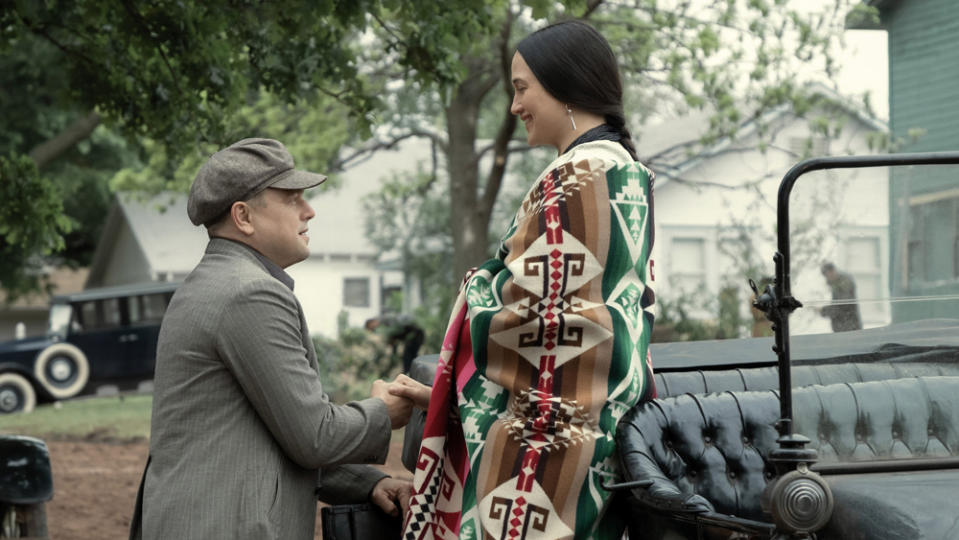
Directed by Martin Scorsese
Essay by Alfonso Cuarón
As Balzac wrote in “Père Goriot”: “The secret of great fortunes without apparent cause is a crime forgotten, for it was properly done.” In “Killers of the Flower Moon,” Martin Scorsese lays bare the genocide against Native Americans that is a foundational ground of this nation.
This crime was committed by not by an individual, but by a system that got away with it through a series of acts of Congress, that through their different stages justified killings and displacements, but more importantly, through rewriting the narrative of the country.
This historical re-write was present in much of the mythology of Westerns that Scorsese enjoyed while growing up, and that now he unveils, true to his methods, through a character uncomfortable in his own skin and tormented by the amorality that justifies his actions.
But, as opposed to the visceral approach of most of his films, Scorsese has chosen a distant and reflective stance, favoring atmosphere over narrative, denying us the easy satisfaction of moral superiority to the men on screen who managed to justify their hideous betrayals of their loved ones and still pretend to have a soul, and confronting audiences with the sin by omission that must rightfully haunt the American soul.
Alfonso Cuarón has directed such films as “Roma,” “Gravity” and “Children of Men.”
‘May December’
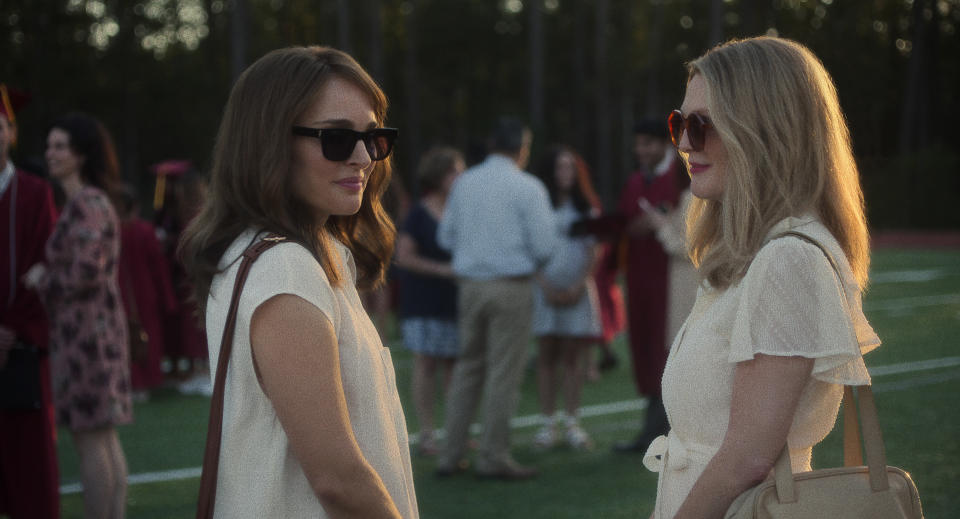
Directed by Todd Haynes
Essay by Kelly Reichardt
Todd Haynes: a sensualist (candy, flowers, sex, music), a formalist, a master of montage, a liberal, a feminist, a journal keeper, a swimmer, a lover of TCM and long baths. The hardest working, least cynical person I know! His latest film is the incredible “May December.” Ingmar Bergman’s “Persona” has been in the Todd Haynes canon for decades — long before the script for “May December” came around. Every Haynes film is structurally in conversation with a film that lives deep inside him, that he knows in and out.
In the case of “May December,” Michel Legrand’s score from Joseph Losey’s “The Go Between” is of equal importance. He’s been playing that score nonstop since 2022. But that’s how it is with Todd. He gets totally obsessed and his enthusiasm is very contagious. If you’re lucky enough to hang around from first drafts of a script to last tweaks on a sound mix, it’s a ride where you’re bound to get turned on to all kinds of things. Each of Todd’s projects generates paintings and drawings and in the case of “May December,” you are going to be hearing that score in your sleep. The score turns out to be essential to the humor in the film. It’s a very funny film. It’s superbly morally ambiguous the way his films are. (Think of Julianne Moore in her igloo at the end of “Safe.”) The great late filmmaker George Kuchar once wrote: “Go to museums, movie theaters, bookstores and playhouses so that a bombardment of culture can seep in and then leak out in a new form when expulsion time beckons. But please be sure to live also and get a good dosage of trash and junk art that’s of value too and can be turned into gold at a later date.”
Who else but Todd Haynes could smoothly mix the frames and dark undercurrents of Bergman with the tabloid story of Mary Kay Letourneau? As I write this, it reminds me that I was once trying to figure out how to make the MTV show “16 and Pregnant” into an art film. Todd said, “‘It’s Bergman’s ‘Summer With Monica’”!
Kelly Reichardt has directed such films as “First Cow,” “Showing Up” and “Certain Women.”
‘Nyad’

Directed by Elizabeth Chai Vasarhelyi and Jimmy Chin
Essay by Barry Levinson
Elizabeth Chai Vasarhelyi and Jimmy Chin have traded in the realm of nonfiction for 20 years, capturing the profound and the mundane of their subjects — and sometimes that’s the same thing — with equal aplomb. They’ve found thematically driven narrative in the chaos of actual life many times over, but “Nyad” marks the first occasion they’ve turned their lens to the manufactured. I use that word willfully, because the film is of course about the very real Diana Nyad and her amazing quest to swim from Cuba to Florida in her 60s without a shark cage. But it’s also a drama, where everything on the screen has to be conjured by artists, rather than captured and molded by documentarians. Elizabeth and Jimmy succeeded beyond measure in this pivot, finding ways to allow for the kinds of spontaneity with actors that they would often encounter when documenting real-life subjects. It’s very easy to lose a handle on that sense of authenticity, to be foiled by the specter of artificiality that hovers over the proceedings of drama. But with a disciplined eye trained on a complicated and flawed character — a fearless woman who is not afraid to fight for her dream and embrace her ambition — they managed to connect their audience with this woman and to elevate both her and her accomplishment into the realm of the legendary. What’s more, the characters are never lost in the mechanics of the feat on display. The bond shared on screen by Annette Bening and Jodie Foster is palpable, a crucial ingredient that Elizabeth and Jimmy bring forth in beautiful ways.
Filmmaker and producer Barry Levinson won an Oscar for “Rain Main.”
‘Past Lives’

Directed by Celine Song
Essay by Daniel Scheinert
A quick summary of “Past Lives” sounds like a slight riff on the love triangle rom-com we’ve seen a thousand times. But here I am writing about it with countless images and ideas vividly rattling around in my brain that are so unique to Celine Song’s movie. Who is your Hae Sung? Or maybe you’re a Hae Sung! Have you felt in-yun since seeing the movie? Are you staring at strangers at bars more than ever making up stories about their bittersweet lives? I’ve been having these thoughts all year. I found myself chatting with an immigrant friend wishing I could switch into their first language to explore the complexity of that past life. I was chatting with a childhood friend, felt my own past life pour out of me, and the image of Nora’s Skype call flooded into my brain.
It’s remarkable, the way she pushed past the story of “picking mister right” and the story of “fighting to win the girl” and somehow brought her audience to this painfully relatable heartbreak on the other side of those stories. I’m inspired by it. And mystified by how the filmmaking team did it. But when I was lucky enough to see a Q&A and have some brunch with Celine, I saw how curious and thoughtful and passionate and charmingly bossy she was, and I was instantly convinced that this movie was no accident. It’s a smart, confident, unique poem because Celine is a smart, confident, unique poet.
Daniel Scheinert co-wrote and co-directed “Everything Everywhere All at Once. “
‘Priscilla’
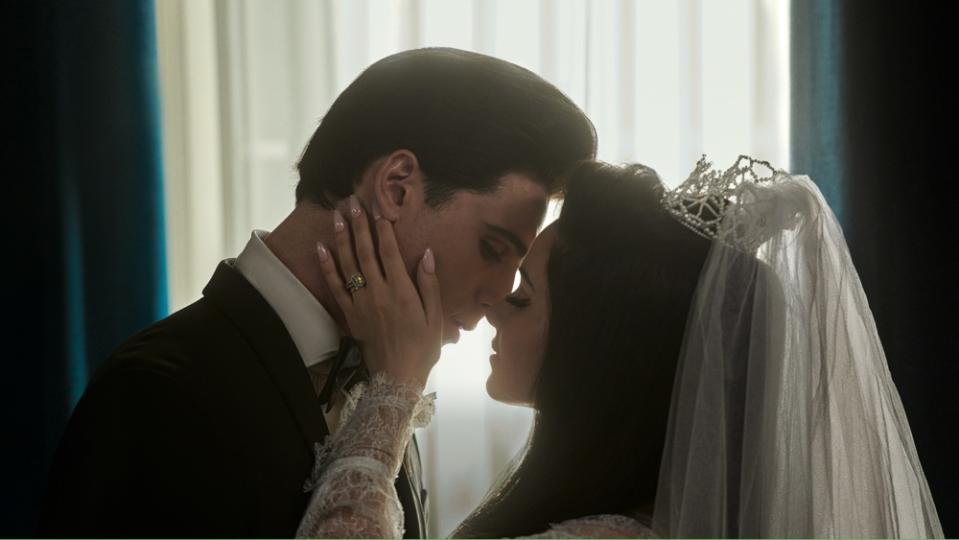
Directed by Sofia Coppola
Essay by Jane Campion
Don’t be fooled by the apparent softness of Sofia Coppola’s vision or the gentle sensitivity of her gaze, it’s just that Sofia plays soft to deliver tough. There is so much dare, risk and rigor in Sofia’s filmmaking, so much radical trust that it scares the pants off lesser filmmakers. Sofia might indulge in some delightful period joys like painted toenails on carpet piles — YUM — but the truth, the radical freedom and presence of her actors Cailee Spaeny and Jacob Elordi is exceptionally real. How does she get these performances? It’s a mystery and it’s Sofia’s high-wire act of zero manipulation, her super power of dare and Zen.
What she unfolds in “Priscilla” is a love story between a 14-year- old lonely girl touchingly and unflinchingly determined and Elvis, the hip-swiveling sexy heartthrob of the world. It is a rare and breathtakingly intimate portrait of a love affair that blooms then sours. Elvis cherishes the young Priscilla and grooms her to his taste — the massive black beehive and curated wardrobe — but he’s bossy and spoiled, a grieving mummy’s boy, a cheat, a disinterested lover and all too soon a broken then tragically dead superstar. It’s a terrible deflation but also liberating — how much have all of us 14-year-old girls wanted to capture the heart of a rock star? What greater reassurance could there be for anxious socially awkward teens that we are beautiful and special? But Sofia is here to tell us, all that, it’s a dream then a f-king nightmare, and her staging and the actor’s performances are so brilliantly true we just can’t doubt it.
Jane Campion’s films include “The Power of the Dog,” “The Piano” and series “Top of the Lake.“
‘Saltburn’

Directed by Emerald Fennell
Essay by Drew Goddard
You’re gonna see some things you’ve never seen before.
The first time you watch “Saltburn,” you’ll assume I’m referring to Those Scenes. The ones that make the audience shift and squirm as they question Emerald Fennell’s not really gonna do this, is she? The ones that make them gasp with delight when the answer is Oh yes, she sure is.
On subsequent viewings, you’ll realize I’m talking about Something Else. An astonishing level of passion and vulnerability from a cast and crew as they journey together from Those Opening Credits to That Final Shot. You can see their blood and terror and hunger in every frame. The way Linus Sandgren’s camera is simultaneously seducing and oppressing … his lighting finding flashes of empathy in the most malevolent moments … the way Suzie Davies’ sets slowly deconstruct the formalism of the first third so that by the end, when those Red Curtains close, the line between performer and production design is obliterated…
And this cast… this cast! The way they give themselves to the audience moment to moment… the risks they take… the lights they find. All led by the exquisite Barry Keoghan, who opens up his veins for us scene after scene after scene…
This is a group of artists who feel safe and protected and emboldened to do truly dangerous work. This only happens when you have a director in complete command of her craft. You can feel Emerald just out of frame, lifting them ever upwards, upwards, upwards. It is staggering, fearless filmmaking. And thank God they’ve asked us to dance with them while the house burns right down around us all.
Drew Goddard has directed and exec produced such series as “The Good Place” and “Bad Times at the El Royale.”
‘The Taste of Things’
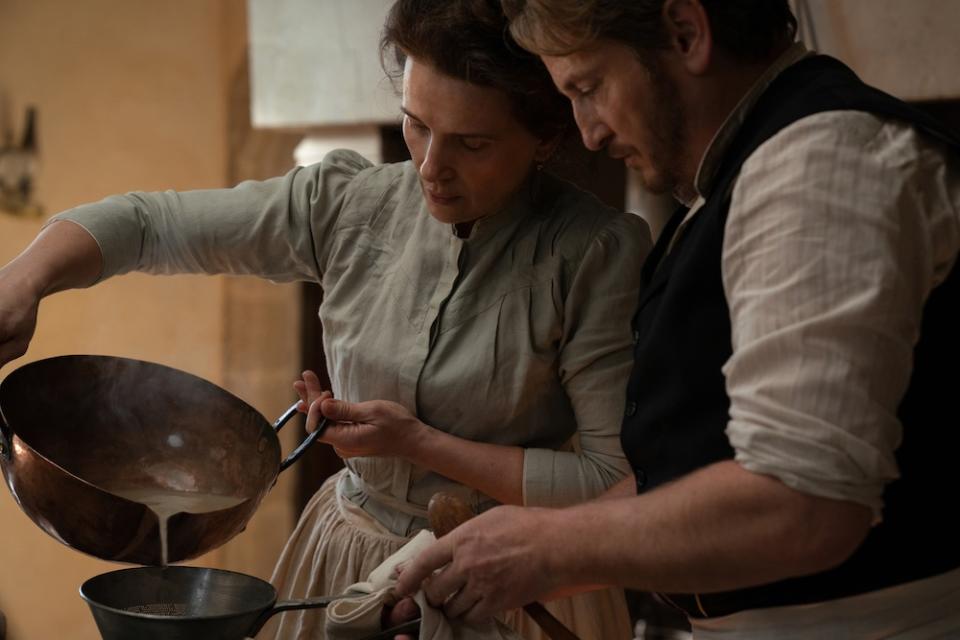
Directed by Tran Anh Hung
Essay by James Mangold
I have admired the work of Tran Anh Hung since his remarkable first feature “The Scent of Green Papaya” (winner of the Cannes Film Festival Camera d’Or in 1993 as well as an Oscar nominee for best foreign language film). And I have continued to be inspired by his moving and graceful work for over 30 years. His films offer mesmerizing and cinematic explorations of love, death, family and domestic power. But Tran does not examine these themes through conventional movie conflict (watching characters say things), but, more powerfully, through an obsessive attention to detail and behavior — what characters DO and how they do it.
Tran follows the same North Star as humanist heroes like Bergman, Bresson and Ozu. And like these legends, his latest work finds transcendence in rigorous habits and process. “Le Pot au Feu” (or “The Taste of Things” as it is titled in English) reveals as much from the performance of his actors’ hands as we see in their expressive faces.
Food and its preparation have been featured in several of Tran’s films, but in “The Taste of Things” he outdoes himself. The obsessive passion shared by the principal characters (portrayed by the glorious Juliette Binoche and Benoît Magimel) is unique and sublime. The way Tran’s camera takes in every detail of this kitchen’s operation is breathtaking, both intimate and epic. And the drama that transpires within this space is about far more than food. This is a film about the pursuit of perfection — a pursuit shared by both the characters and the filmmaker — and the effort required to even approach this goal is not presented as a torturous journey but rather a holy quest to share and demonstrate a pure love.
James Mangold’s features include “Indiana Jones and the Dial of Destiny,” “Ford v. Ferrari,” “Walk the Line” and “Logan.“
‘Tótem’
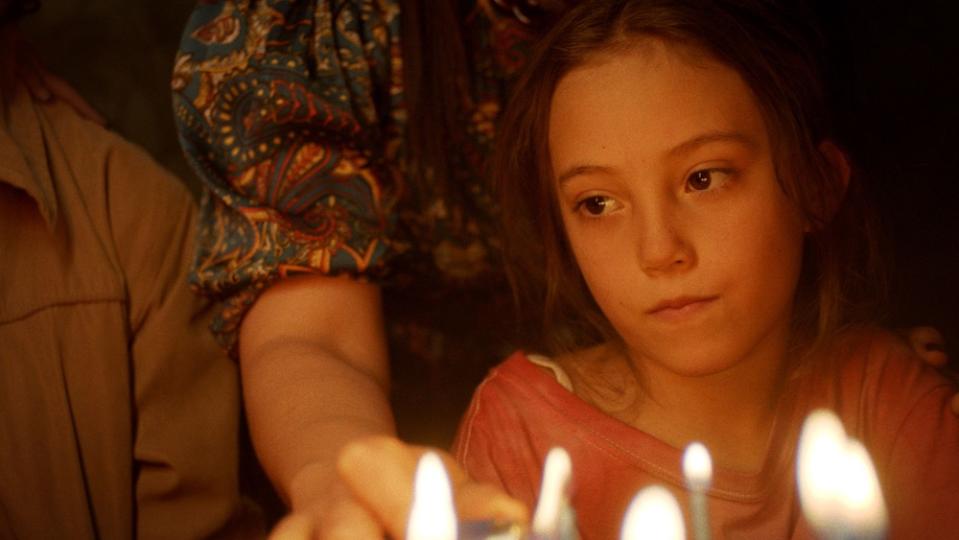
Directed by Lila Avilés
Essay by Kirsten Johnson
“Never work with animals and children,” said the actor W.C. Fields. Scores of film directors have taken his words to heart. The reason? Animals and children can’t be controlled. Fields’ self-lacerating implication was that animals and children would definitely upstage him.
Lila Avilés has no time for any of these fears. There are animals and children in almost every shot of her exuberant film “Tótem.” At its center stage, she lifts a child high onto her shoulders and up above the circus of it all. Avilés’ home of a movie is cheeky and intimate from the very first shot, in which a mother encourages her child by example. She wants her daughter to let feelings out instead of holding them in.
The two erupt in their own distinct laugh when someone bangs at the door of their privacy; the mischievous scene charts a path for how almost every dense shot of “Tótem” will keep getting interrupted. Avilés chooses to film within a nearly square format, which makes it feel as if she is holding everyone and everything within her loving hands. Small groupings of people and animals are always in motion and reconfiguring themselves: watching, misunderstanding and trying to figure out how to take care of each other.
The title of the film, “Tótem,” could be a metaphor for what it means to live within a family. Avilés gently asks us to reconsider whose shoulders we stand on in order to exist, and to wonder more about what taking care of us has demanded of them. Throughout her joyful film, the precarity of such a tall tower made of so many humans and animals wobbles and steadies itself in scores of unexpected ways.
Then Avilés ultimately stares straight into the eyes of the little girl who’s just realized that the totem is about to come crashing down. “Tótem” boldly cuts to black and I gasped at Avilés’ magic trick. She leaves us staring at a black screen shimmering with the afterglow of ghosts of totems past. Stay for the gorgeous credits which stack the totem right back up again.
Kirsten Johnson’s films include “Dick Johnson Is Dead” and “Cameraperson.”
‘The Zone of Interest’
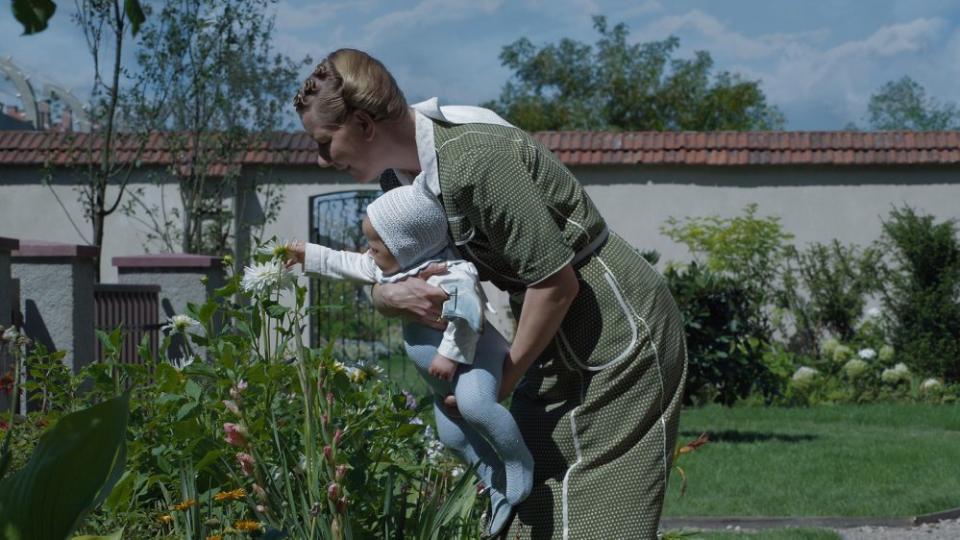
Directed by Jonathan Glazer
Essay by Todd Field
It begins in birdsong. A summer idyll. The plucking of wild strawberries, bathing in a lazy river, a family picnic with the bucolic beauty and old-world charm of a Carl Larsson painting.
Paradise.
The etymological origin of the word is “walled garden.” And this is where we find ourselves in Jonathan Glazer’s extraordinary film “The Zone of Interest.” Within that wall you will smell, taste and, most importantly, see and hear what it contains.
In just 10 minutes, Glazer achieves what one could argue is the most chilling cinematic depiction of the Holocaust ever committed to film — through the simple act of Hedwig Höss applying another woman’s lipstick. A woman we will never meet, yet whose absence is stomach-turning to the extreme. The thief, and Frau Höss as played by Sandra Hüller supplies new meaning to the word, lives in a house whose guestbook glows with reviews dutifully read aloud by children following their parents’ goosesteps. But Glazer doesn’t point or give us signposts, he simply adopts us into the family where we take up residence in the most quotidian and intimate manner.
The experience is naked, and he trusts we will pay attention much in the way a child listens to their parents from the backseat of a car. And while Glazer’s use of sound is masterful, so is his eye, the way it forces us to see the world through the Höss family’s, ultimately making us complicit when what we really want to do is scream at the screen.
Stop. Please God, make them stop.
For those familiar with Glazer’s films it’s no surprise his approach here is unencumbered by tropes, genre conceits, or the cinematic shorthand we often take for granted. Over his twenty-four-year career as one of our finest filmmakers, Glazer has consistently executed high-wire interpretations of genre, and in the process completely reinvented them: crime (“Sexy Beast”), the paranormal (“Birth”), science fiction (“Under the Skin”). His pictures within these frames are mind-blowingly unique, as if he’d never seen anything that had been done before.
“The Zone of Interest” is just as enigmatic and urgent. For we live in a time fraught with all kinds of walls used to ghettoize the other. A paradise from which it feels harder and harder to escape.
Glazer’s art drives us to a place where we have no choice but to try.
Best of Variety

 Yahoo News
Yahoo News 
